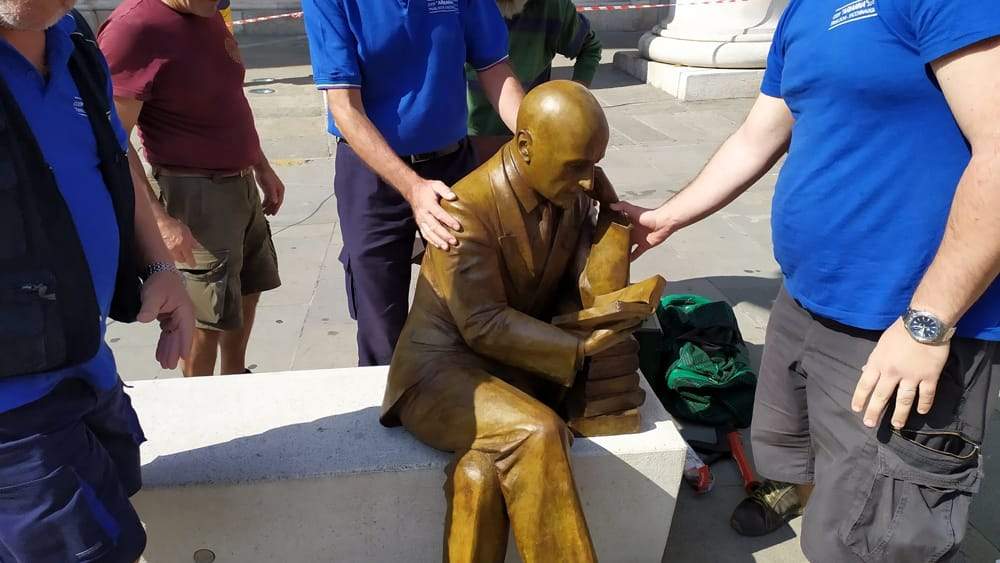Trieste, criticized statue of Gabriele d'Annunzio installed on centenary of his feat
Finally, in Trieste, a much-criticized and much-contested statue dedicated to Gabriele d’Annunzio has been installed in Piazza Borsa, on the very day when the 100th anniversary of theFiume enterprise is being celebrated (the poet, leading his “legionaries,” proclaimed the annexation of the Quarnarine city to the Kingdom of Italy on September 12, 1919). The sculpture, made of bronze (cast using the lost-wax technique by the Fondart foundry), created by Alessandro Verdi, depicts the vate bent over reading a book, as in a famous photograph of him in the same pose. The operation had a total cost of 18,000 euros.
The statue was strongly desired by Trieste’s Leghist-driven municipal administration, which intended in this way to pay homage to the poet, but public opinion was divided between critics and supporters of the operation. The president of the Il Vittoriale Foundation, historian Giordano Bruno Guerri, declared that “this monument will be a tribute to the literary d’Annunzio, linked to the city of Trieste, as the highest representative of the irredentism of which the Julian capital was a symbol.” Yet, given the day of the inauguration, one would think that this is not just a tribute to the literary d’Annunzio. In any case, the mayor of Trieste, Roberto Dipiazza, paid tribute to the statue with a “Welcome back to Trieste Gabriele d’Annunzio,” but of the same opinion are not the naysayers, beginning with the mayor of Rijeka, Vojko Obersnel, who in July wrote an open letter recalling that d’Annunzio “occupied Rijeka in 1919” and that “he was the forerunner of fascism and the inspiration to Benito Mussolini, who in turn, very willingly accepted Hitler’s ideology and joined the bloody missions during World War II, one of the bloodiest wars in the history of the world.” According to Obersnel, “because of d’Annunzio, Fiume experienced among the first the lethal hand of fascism. So, d’Annunzio was not a timid poet, as so many want to present him, but an aggressor and a tyrant.”
But as early as June, a petition against the statue was launched, able to collect as many as 1,500 signatures in the first three days. The promoter, Alessandro de’ Vecchi, wrote that “d’Annunzio had nothing to do with Trieste, he was mocked even by the population when he lost his eye, according to him in a heroic action by flying over the city but actually lost due to a badly treated infection.” In addition, the supporter of the signature collection added, “the location in front of the Chamber of Commerce building is offensive, it is probably a tribute by the right-wing junta and its lists composed also of former comrades, to an avowedly fascist congressman residing in the same square.” Dipiazza had responded by intimating to “put an end to these divisions of the twentieth century.”
Those in favor, however, include the positions of Trieste writer Claudio Magris and art historian Vittorio Sgarbi. Magris, in an article in the Corriere della Sera, premising his lack of interest in whether or not there should be a monument to d’Annunzio in Trieste and stating that the poet would mock his detractors today, emphasized the literary qualities of the Vate: “D’Annunzio was and therefore is, as even those who rightly detest him politically and civilly know, a great, great poet of Italy, of Europe and of the world, a conscious cynic and brilliant poet who lived through and helped create, as a protagonist, the radical worldwide transformation of poetic language, of art in its relation to life and money.” Moreover, Magris emphasized that the Fiume enterprise is “far more complex than the facile way in which it is judged. The fundamental nationalist component is unquestionable, but in Rijeka D’Annunzio, during his ”Regency of Carnaro,“ opened Italian, Croatian, and Hungarian schools, respecting and indeed enhancing the city’s multifaceted character, and reintroduced divorce. The Carnaro Charter written by Alceste De Ambris introduced significant labor and worker protections.” Sgarbi, for his part, wrote Monday in Il Giornale that the statue “is an honor for Italy” given d’Annunzio’s literary stature.
The controversy, however, has not subsided, and if in recent days the opposition signed a letter in which it asked the alderman to take a step back, today, on social media, the clash has flared up again and comments on the operation are raining down. And d’Annunzio continues to remain one of the most controversial figures in Italian history.
 |
| Trieste, criticized statue of Gabriele d'Annunzio installed on centenary of his feat |
Warning: the translation into English of the original Italian article was created using automatic tools. We undertake to review all articles, but we do not guarantee the total absence of inaccuracies in the translation due to the program. You can find the original by clicking on the ITA button. If you find any mistake,please contact us.




























